帶你完全掌握Java NIO(總結分享)
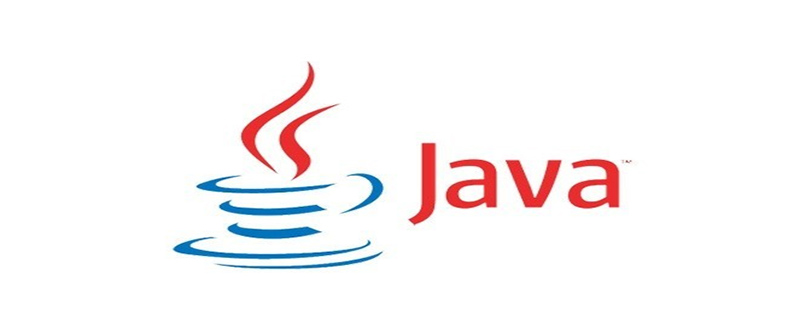
推薦學習:《》
一、Java思維導圖
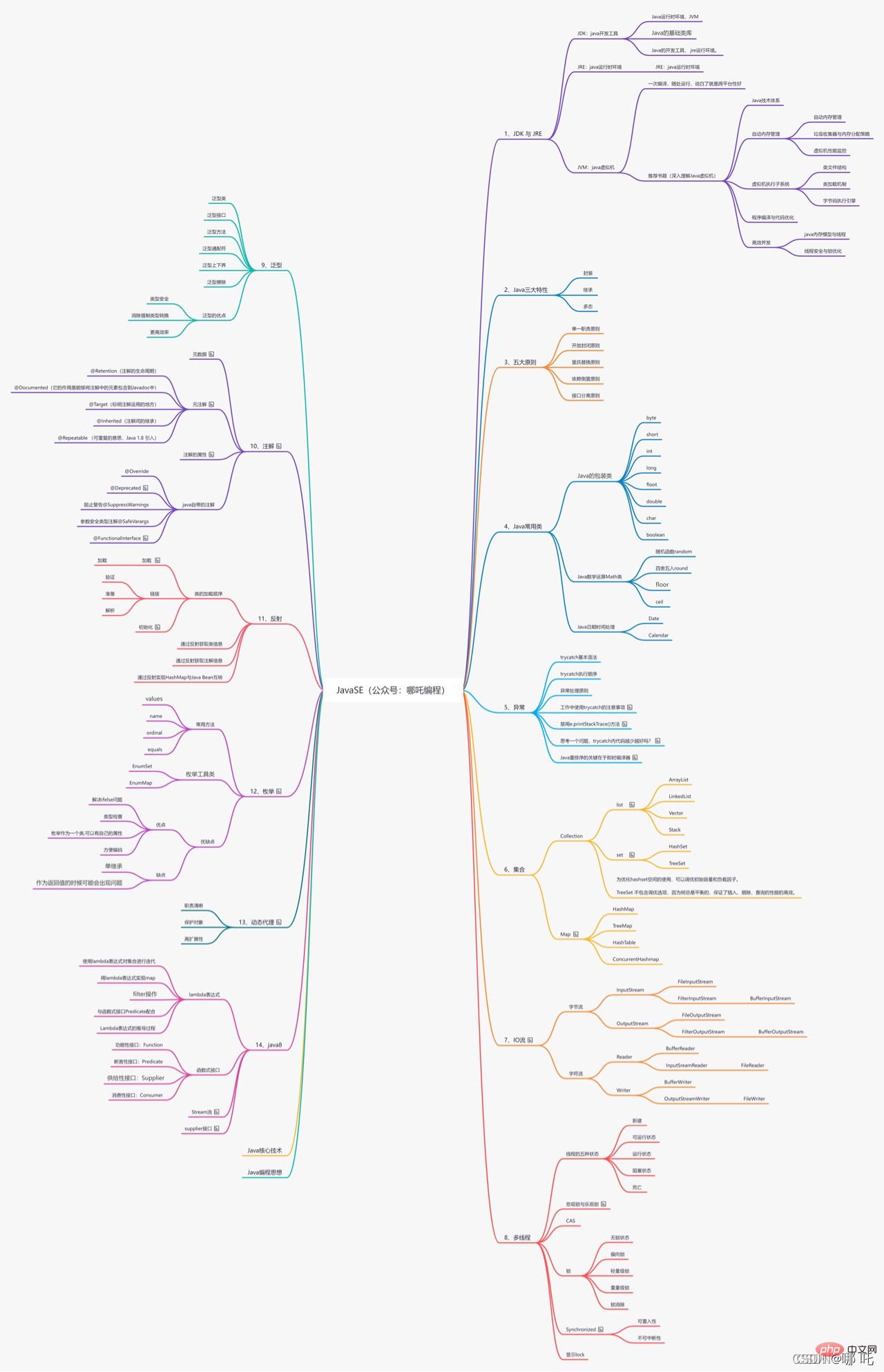
二、I/O模型
I/O模型的本質是用什麼樣的通道進行資料的傳送和接收,很大程度上決定了程式通訊的效能。
Java共支援三種網路程式設計模型:BIO、NIO、AIO
BIO:同步並阻塞,服務實現模式為一個連線一個執行緒,即使用者端有一個連線請求時,伺服器端就需要啟動一個執行緒進行處理。
NIO: 同步非阻塞,伺服器實現模式為一個執行緒處理多個請求連線,即使用者端傳送的請求都會註冊到多路複用器上,多路複用器輪詢到連線有I/O請求就進行處理。
AIO:非同步非阻塞,AIO引入非同步通道的概念,採用了Proactor模式,簡化了程式編寫,有效的請求才啟動執行緒,它的特點是先由作業系統完成後才通知伺服器端。
三、BIO、NIO、AIO應用場景
BIO方式適用於連線數目比較小且固定的架構,這種方式對伺服器資源要求比較高, 並行侷限於應用中,JDK1.4以前的唯一選擇,但程式簡單易理解。
NIO方式適用於連線數目多且連線比較短(輕操作)的架構,比如聊天伺服器,彈幕 系統,伺服器間通訊等。程式設計比較複雜,JDK1.4開始支援。
AIO方式使用於連線數目多且連線比較長(重操作)的架構,比如相簿伺服器,充分 呼叫OS參與並行操作,程式設計比較複雜,JDK7開始支援
四、BIO程式設計簡單流程
伺服器端啟動一個ServerSocket;
使用者端啟動Socket對伺服器進行通 信,預設情況下伺服器端需要對每 個客戶 建立一個執行緒與之通訊;
使用者端發出請求後, 先諮詢伺服器 是否有執行緒響應,如果沒有則會等 待,或者被拒絕;
如果有響應,使用者端執行緒會等待請 求結束後,在繼續執行;
五、NIO核心
NIO 有三大核心部分:Selector(選擇器)、Channel(通道)、Buffer(緩衝區)。
NIO是面向緩衝區,或者說面向塊程式設計,資料讀取到一個 它稍後處理的緩衝區,需要時可在緩衝區中前後移動,這就 增加了處理過程中的靈活性,使用它可以提供非阻塞式的高伸縮性網路。
HTTP2.0使用了多路複用的技術,做到同一個連線並行處理多個請求,而且並行請求 的數量比HTTP1.1大了好幾個數量級。
簡而言之,NIO可以一個執行緒處理多個請求。
六、BIO與NIO比較
BIO 以流的方式處理資料,而 NIO 以塊的方式處理資料,塊 I/O 的效率比流 I/O 高很多;
BIO 是阻塞的,NIO 則是非阻塞的;
BIO基於位元組流和字元流進行操作,而 NIO 基於 Channel(通道)和 Buffer(緩衝區)進 行操作,資料總是從通道讀取到緩衝區中,或者從緩衝區寫入到通道中。Selector(選擇器)用於監聽多個通道的事件(比如:連線請求,資料到達等),因 此使用單個執行緒就可以監聽多個使用者端通道。
七、NIO 三大核心原理示意圖
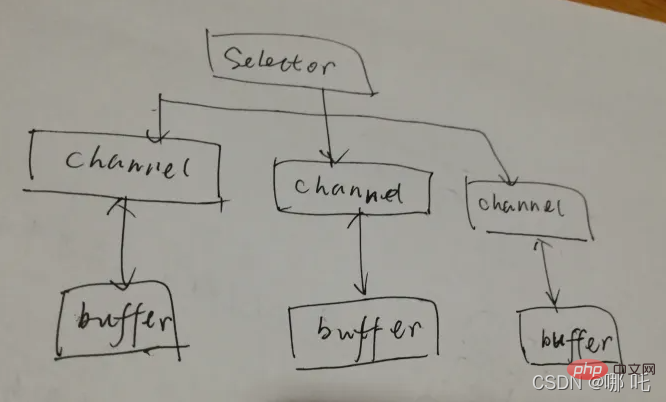
流程圖說明:
Selector 對應一個執行緒, 一個執行緒對應多個channel(連線);
該圖反應了有三個channel 註冊到 該selector //程式;
每個channel 都會對應一個Buffer;
程式切換到哪個channel 是有事件決定的, Event 就是一個重要的概念;
Selector 會根據不同的事件,在各個通道上切換;
Buffer 就是一個記憶體塊 , 底層是有一個陣列;
資料的讀取寫入是通過Buffer, 這個和BIO , BIO 中要麼是輸入流,或者是 輸出流, 不能雙向,但是NIO的Buffer 是可以讀也可以寫, 需要 flip 方法切換;
channel 是雙向的, 可以返回底層作業系統的情況, 比如Linux , 底層的作業系統 通道就是雙向的;
八、緩衝區(buffer)
緩衝區本質上是一個可以讀寫資料的記憶體塊,可以理解成是一個 容器物件(含陣列),該物件提供了一組方法,可以更輕鬆地使用記憶體塊,,緩衝區對 象內建了一些機制,能夠跟蹤和記錄緩衝區的狀態變化情況。Channel 提供從檔案、 網路讀取資料的渠道,但是讀取或寫入的資料都必須經由 Buffer。
在 NIO 中,Buffer 是一個頂層父類別,它是一個抽象類。
1、常用Buffer子類一覽
ByteBuffer,儲存位元組資料到緩衝區;
ShortBuffer,儲存字串資料到緩衝區;
CharBuffer,儲存字元資料到緩衝區;
IntBuffer,儲存整數資料到緩衝區;
LongBuffer,儲存長整型資料到緩衝區;
DoubleBuffer,儲存小數到緩衝區;
FloatBuffer,儲存小數到緩衝區;
2、buffer四大屬性
mark:標記
position:位置,下一個要被讀或寫的元素的索引, 每次讀寫緩衝區資料時都會改變改值, 為下次讀寫作準備。
limit:表示緩衝區的當前終點,不能對緩衝區 超過極限的位置進行讀寫操作。且極限 是可以修改的
capacity:容量,即可以容納的最巨量資料量;在緩 衝區建立時被設定並且不能改變。
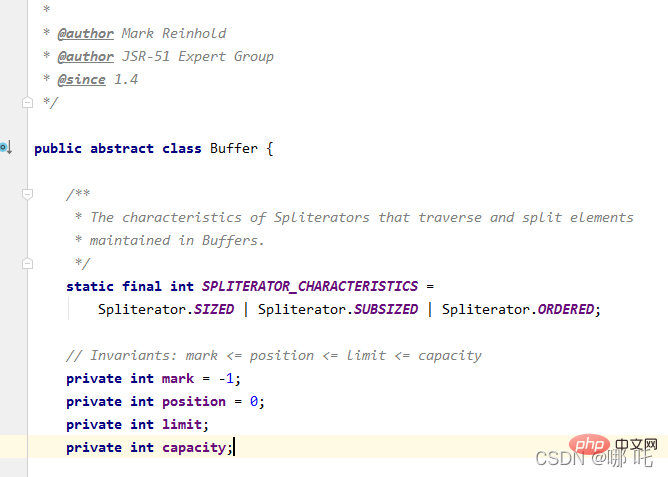
3、buffer常用api
JDK1.4時,引入的api
- public final int capacity( )//返回此緩衝區的容量
- public final int position( )//返回此緩衝區的位置
- public final Buffer position (int newPositio)//設定此緩衝區的位置
- public final int limit( )//返回此緩衝區的限制
- public final Buffer limit (int newLimit)//設定此緩衝區的限制
- public final Buffer mark( )//在此緩衝區的位置設定標記
- public final Buffer reset( )//將此緩衝區的位置重置為以前標記的位置
- public final Buffer clear( )//清除此緩衝區, 即將各個標記恢復到初始狀態,但是資料並沒有真正擦除, 後面操作會覆蓋
- public final Buffer flip( )//反轉此緩衝區
- public final Buffer rewind( )//重繞此緩衝區
- public final int remaining( )//返回當前位置與限制之間的元素數
- public final boolean hasRemaining( )//告知在當前位置和限制之間是否有元素
- public abstract boolean isReadOnly( );//告知此緩衝區是否為唯讀緩衝區
JDK1.6時引入的api
- public abstract boolean hasArray();//告知此緩衝區是否具有可存取的底層實現陣列
- public abstract Object array();//返回此緩衝區的底層實現陣列
- public abstract int arrayOffset();//返回此緩衝區的底層實現陣列中第一個緩衝區元素的偏移量
- public abstract boolean isDirect();//告知此緩衝區是否為直接緩衝區
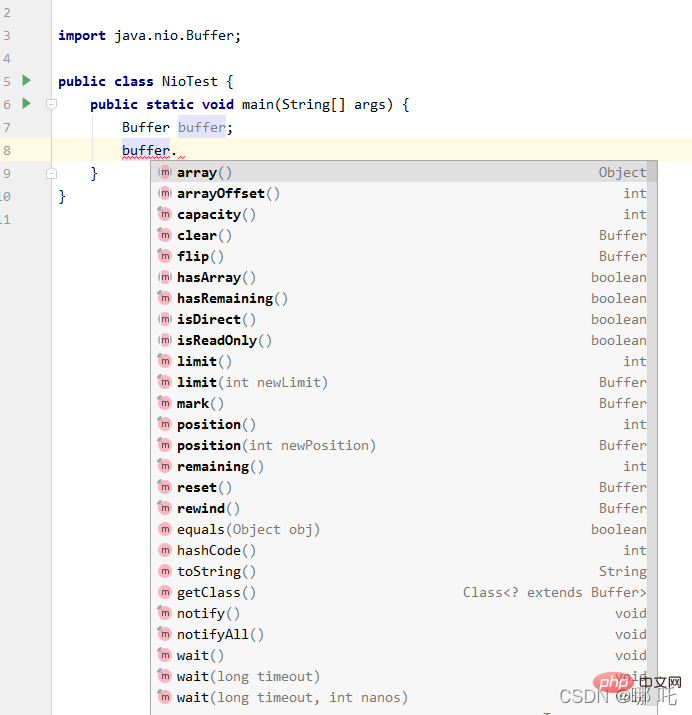
九、通道(channel)
1、基本介紹
(1)NIO的通道類似於流
- 通道可以同時進行讀寫,而流只能讀或者只能寫;
- 通道可以實現非同步讀寫資料
- 通道可以從緩衝讀資料,也可以寫資料到緩衝
(2)BIO 中的 stream 是單向的,例如 FileInputStream 對 象只能進行讀取資料的操作,而 NIO 中的通道 (Channel)是雙向的,可以讀操作,也可以寫操作。
(3)Channel在NIO中是一個介面
(4)常用的 Channel 類有:FileChannel、 DatagramChannel、ServerSocketChannel 和 SocketChannel。ServerSocketChanne 類似 ServerSocket , SocketChannel 類似 Socket。
(5)FileChannel 用於檔案的資料讀寫, DatagramChannel 用於 UDP 的資料讀寫, ServerSocketChannel 和 SocketChannel 用於 TCP 的資料讀寫。
2、FileChannel
FileChannel主要用來對本地檔案進行 IO 操作,常見的方法有:
read,從通道讀取資料並放到緩衝區中
write,把緩衝區的資料寫到通道中
transferFrom,從目標通道 中複製資料到當前通道
transferTo,把資料從當 前通道複製給目標通道
3、關於Buffer 和 Channel的注意事項和細節
ByteBuffer 支援型別化的put 和 get, put 放入的是什麼資料型別,get就應該使用 相應的資料型別來取出,否則可能有 BufferUnderflowException 異常。
可以將一個普通Buffer 轉成唯讀Buffer。
NIO 還提供了 MappedByteBuffer, 可以讓檔案直接在記憶體(堆外的記憶體)中進 行修改, 而如何同步到檔案由NIO 來完成。
NIO 還支援 通過多個 Buffer (即 Buffer 陣列) 完成讀寫操作,即 Scattering 和 Gathering。
十、Selector(選擇器)
1、基本介紹
Java 的 NIO,用非阻塞的 IO 方式。可以用一個執行緒,處理多個的使用者端連 接,就會使用到Selector(選擇器)。
Selector 能夠檢測多個註冊的通道上是否有事件發生,如果有事件發生,便獲取事件然 後針對每個事件進行相應的處理。這樣就可以只用一個單執行緒去管理多個 通道,也就是管理多個連線和請求。
只有在 連線/通道 真正有讀寫事件發生時,才會進行讀寫,就大大地減少 了系統開銷,並且不必為每個連線都建立一個執行緒,不用去維護多個執行緒。
避免了多執行緒之間的上下文切換導致的開銷。
2、selector的相關方法
open();//得到一個選擇器物件
select(long timeout);//監控所有註冊的通道,當其 中有 IO 操作可以進行時,將 對應的 SelectionKey 加入到內部集合中並返回,引數用來 設定超時時間
selectedKeys();//從內部集合中得 到所有的 SelectionKey。
3、注意事項
NIO中的 ServerSocketChannel功能類似ServerSocket,SocketChannel功能類 似Socket。
十一、通過NIO實現簡單的伺服器端使用者端通訊
1、伺服器端
package com.nezha.guor.nio;import java.io.IOException;import java.net.InetSocketAddress;import java.nio.ByteBuffer;import java.nio.channels.*;import java.util.Iterator;public class NioServer {
private Selector selector;
private ServerSocketChannel serverSocketChannel;
private static final int PORT = 8080;
public NioServer() {
try {
//獲得選擇器
selector = Selector.open();
serverSocketChannel = ServerSocketChannel.open();
//繫結埠
serverSocketChannel.socket().bind(new InetSocketAddress(PORT));
//設定非阻塞模式
serverSocketChannel.configureBlocking(false);
//將該ServerSocketChannel 註冊到selector
serverSocketChannel.register(selector, SelectionKey.OP_ACCEPT);
}catch (IOException e) {
System.out.println("NioServer error:"+e.getMessage());
}
}
public void listen() {
System.out.println("監聽執行緒啟動: " + Thread.currentThread().getName());
try {
while (true) {
int count = selector.select();
if(count > 0) {
//遍歷得到selectionKey集合
Iterator<SelectionKey> iterator = selector.selectedKeys().iterator();
while (iterator.hasNext()) {
SelectionKey key = iterator.next();
if(key.isAcceptable()) {
SocketChannel sc = serverSocketChannel.accept();
sc.configureBlocking(false);
sc.register(selector, SelectionKey.OP_READ);
System.out.println(sc.getRemoteAddress() + " 上線 ");
}
//通道傳送read事件,即通道是可讀的狀態
if(key.isReadable()) {
getDataFromChannel(key);
}
//當前的key 刪除,防止重複處理
iterator.remove();
}
} else {
System.out.println("等待中");
}
}
}catch (Exception e) {
System.out.println("listen error:"+e.getMessage());
}
}
private void getDataFromChannel(SelectionKey key) {
SocketChannel channel = null;
try {
channel = (SocketChannel) key.channel();
ByteBuffer buffer = ByteBuffer.allocate(1024);
int count = channel.read(buffer);
//根據count的值做處理
if(count > 0) {
String msg = new String(buffer.array());
System.out.println("來自使用者端: " + msg);
//向其它的使用者端轉發訊息(排除自己)
sendInfoToOtherClients(msg, channel);
}
}catch (IOException e) {
try {
System.out.println(channel.getRemoteAddress() + " 離線了");
//取消註冊
key.cancel();
}catch (IOException ex) {
System.out.println("getDataFromChannel error:"+ex.getMessage());
}
}finally {
try {
channel.close();
}catch (IOException ex) {
System.out.println("channel.close() error:"+ex.getMessage());
}
}
}
//轉發訊息給其它客戶(通道)
private void sendInfoToOtherClients(String msg, SocketChannel self ) throws IOException{
System.out.println("伺服器轉發訊息中...");
System.out.println("伺服器轉發資料給使用者端執行緒: " + Thread.currentThread().getName());
//遍歷 所有註冊到selector 上的 SocketChannel,並排除 self
for(SelectionKey key: selector.keys()) {
Channel targetChannel = key.channel();
//排除自己
if(targetChannel instanceof SocketChannel && targetChannel != self) {
SocketChannel dest = (SocketChannel)targetChannel;
//將資訊儲存到buffer
ByteBuffer buffer = ByteBuffer.wrap(msg.getBytes());
//將buffer資料寫入通道
dest.write(buffer);
}
}
}
public static void main(String[] args) {
//建立伺服器物件
NioServer nioServer = new NioServer();
nioServer.listen();
}}2、使用者端
package com.nezha.guor.nio;import java.io.IOException;import java.net.InetSocketAddress;import java.nio.ByteBuffer;import java.nio.channels.SelectionKey;import java.nio.channels.Selector;import java.nio.channels.SocketChannel;import java.util.Iterator;import java.util.Scanner;public class NioClient {
private final int PORT = 8080; //伺服器埠
private Selector selector;
private SocketChannel socketChannel;
private String username;
public NioClient() throws IOException {
selector = Selector.open();
socketChannel = socketChannel.open(new InetSocketAddress("127.0.0.1", PORT));
//設定非阻塞
socketChannel.configureBlocking(false);
//將channel註冊到selector
socketChannel.register(selector, SelectionKey.OP_READ);
username = socketChannel.getLocalAddress().toString().substring(1);
System.out.println(username + " is ok...");
}
//向伺服器傳送訊息
public void sendInfo(String info) {
info = username + " 說:" + info;
try {
socketChannel.write(ByteBuffer.wrap(info.getBytes()));
}catch (IOException e) {
System.out.println("sendInfo error:"+e.getMessage());
}
}
//讀取從伺服器端回覆的訊息
public void readInfo() {
try {
int readChannels = selector.select();
if(readChannels > 0) {
Iterator<SelectionKey> iterator = selector.selectedKeys().iterator();
while (iterator.hasNext()) {
SelectionKey key = iterator.next();
if(key.isReadable()) {
//得到相關的通道
SocketChannel sc = (SocketChannel) key.channel();
//得到一個Buffer
ByteBuffer buffer = ByteBuffer.allocate(1024);
//讀取
sc.read(buffer);
//把讀到的緩衝區的資料轉成字串
String msg = new String(buffer.array());
System.out.println(msg.trim());
}
}
iterator.remove(); //刪除當前的selectionKey, 防止重複操作
} else {
System.out.println("沒有可以用的通道...");
}
}catch (Exception e) {
System.out.println("readInfo error:"+e.getMessage());
}
}
public static void main(String[] args) throws Exception {
NioClient nioClient = new NioClient();
new Thread() {
public void run() {
while (true) {
nioClient.readInfo();
try {
Thread.currentThread().sleep(2000);
}catch (InterruptedException e) {
System.out.println("sleep error:"+e.getMessage());
}
}
}
}.start();
//傳送資料給伺服器端
Scanner scanner = new Scanner(System.in);
while (scanner.hasNextLine()) {
nioClient.sendInfo(scanner.nextLine());
}
}}3、控制檯輸出
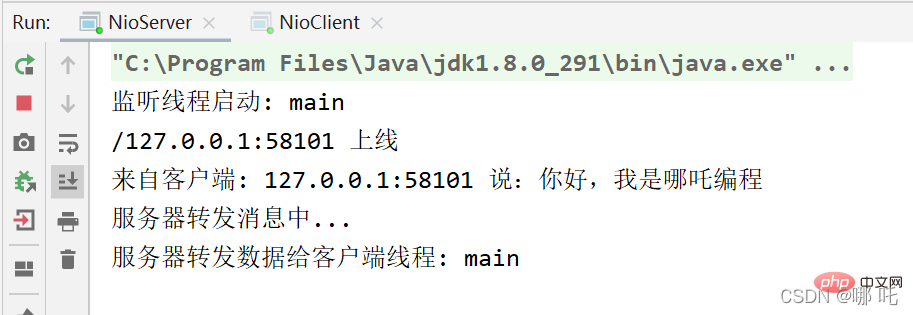

推薦學習:《》
以上就是帶你完全掌握Java NIO(總結分享)的詳細內容,更多請關注TW511.COM其它相關文章!